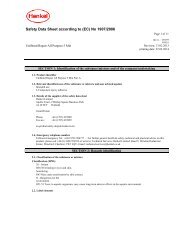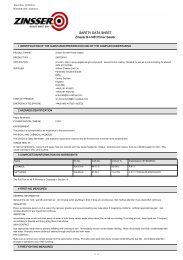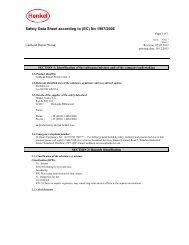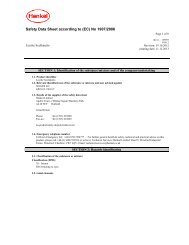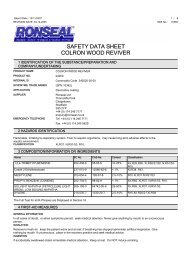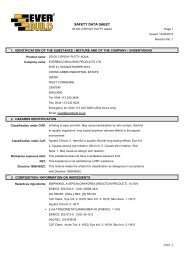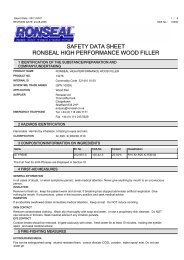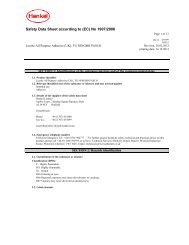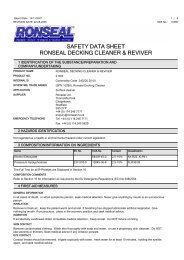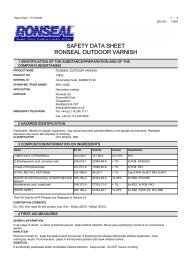SAFETY DATA SHEET Sticky Stuff Remover - De-Solv-It
SAFETY DATA SHEET Sticky Stuff Remover - De-Solv-It
SAFETY DATA SHEET Sticky Stuff Remover - De-Solv-It
You also want an ePaper? Increase the reach of your titles
YUMPU automatically turns print PDFs into web optimized ePapers that Google loves.
Revision Date: 10.01.111/6<strong>SAFETY</strong> <strong>DATA</strong> <strong>SHEET</strong><strong>Sticky</strong> <strong>Stuff</strong> <strong>Remover</strong>SECTION 1: IDENTIFICATION OF THE SUBSTANCE/MIXTURE AND OF THE COMPANY/UNDERTAKING1.1. Product identifierProduct Name<strong>Sticky</strong> <strong>Stuff</strong> <strong>Remover</strong>Product No. 1019, 1022Internal IdE07141.2. Relevant identified uses of the substance or mixture and uses advised againstIdentified usesReleasing agent1.3. <strong>De</strong>tails of the supplier of the safety data sheetSupplier:1.4. Emergency telephone numberMykal Industries LtdFarnsworth House, Morris Close, Park FarmIndustrial Estate, Wellingborough, Northants, NN86XFTel, 0044(0)1933 402822Fax, 0044(0)1933 402488e-mail, enquiries@mykal.co.uk+44(0)1933 402822 Mon- Thurs 09.00-17.00, Fri 09.00-15.00SECTION 2: HAZARDS IDENTIFICATION2.1. Classification of the substance or mixtureClassification (1999/45/EEC) Xn;R65. R66.Human HealthThe hazardous properties of the product are considered limited. May cause minor irritation on skin contact.EnvironmentThe product is not expected to be hazardous to the environment.2.2. Label elementsContains:LabellingAliphatic HydrocarbonHarmfulRisk PhrasesSafety Phrases2.3. Other hazardsR65R66S2S25S62S28AHarmful: may cause lung damage if swallowed.Repeated exposure may cause skin dryness or cracking.Keep out of the reach of children.Avoid contact with eyes.If swallowed, do not induce vomiting: seek medical advice immediately andshow this container or label.After contact with skin, wash immediately with plenty of soap and water.Do not use near naked flames or on/close to hot surfaces.SECTION 3: COMPOSITION/INFORMATION ON INGREDIENTS3.2. Mixtures
2/6<strong>Sticky</strong> <strong>Stuff</strong> <strong>Remover</strong>Aliphatic Hydrocarbon 60-100%CAS-No.: 64742-47-8 EC No.: 265-149-8Classification (EC 1272/2008)EUH066Asp. Tox. 1 - H304Classification (67/548/EEC)Xn;R65.R66.Glycol Ether 10-30%CAS-No.: 34590-94-8 EC No.: 252-104-2Classification (EC 1272/2008)Not classified.Classification (67/548/EEC)Not classified.The Full Text for all R-Phrases and Hazard Statements is Displayed in Section 16Composition CommentsThe product contains organic solvents.SECTION 4: FIRST AID MEASURES4.1. <strong>De</strong>scription of first aid measuresGeneral InformationGet medical attention if any discomfort continues.Inhalation.In case of persistent throat irritation or coughing: Seek medical attention and bring these instructions.IngestionImmediately rinse mouth and drink plenty of water or milk. Keep person under observation. Do not induce vomiting. If vomiting occurs,keep head low. Transport immediately to hospital and bring along these instructions.Skin ContactRemove affected person from source of contamination. Promptly wash contaminated skin with soap or mild detergent and water. Promptlyremove clothing if soaked through and wash as above.Eye ContactImmediately flush with plenty of water for up to 15 minutes. Remove any contact lenses and open eyelids widely. If irritation persists:Continue flushing during transport to hospital. Bring these instructions.4.2. Most important symptoms and effects, both acute and delayed4.3. Indication of any immediate medical attention and special treatment neededNo recommendation given, but first aid may still be required in case of accidental exposure, inhalation or ingestion of this chemical. If indoubt, GET MEDICAL ATTENTION PROMPTLY!SECTION 5: FIREFIGHTING MEASURES5.1. Extinguishing mediaExtinguishing MediaExtinguish with foam, carbon dioxide or dry powder. Do not use water jet as an extinguisher, as this will spread the fire.5.2. Special hazards arising from the substance or mixtureUnusual Fire & Explosion HazardsVapours are heavier than air and may spread near ground to sources of ignition.Specific HazardsVapours are heavier than air and may travel along the floor and in the bottom of containers. Vapours may be ignited by a spark, a hotsurface or an ember.5.3. Advice for firefightersSpecial Fire Fighting ProceduresKeep run-off water out of sewers and water sources. Dike for water control. Keep up-wind to avoid fumes.Protective Measures In FireUse protective equipment appropriate for surrounding materials.SECTION 6: ACCIDENTAL RELEASE MEASURES
3/6<strong>Sticky</strong> <strong>Stuff</strong> <strong>Remover</strong>6.1. Personal precautions, protective equipment and emergency proceduresIn case of spills, beware of slippery floors and surfaces. Use protective gloves, goggles and suitable protective clothing.6.2. Environmental precautionsNot relevant considering the small amounts used.6.3. Methods and material for containment and cleaning upExtinguish all ignition sources. Avoid sparks, flames, heat and smoking. Ventilate. Absorb in vermiculite, dry sand or earth and placeinto containers. Clean contaminated area with oil-removing material.6.4. Reference to other sectionsSECTION 7: HANDLING AND STORAGE7.1. Precautions for safe handlingAvoid eating, drinking and smoking when using the product.7.2. Conditions for safe storage, including any incompatibilitiesKeep away from heat, sparks and open flame. Store in a cool and well-ventilated place.Storage ClassUnspecified storage.7.3. Specific end use(s)SECTION 8: EXPOSURE CONTROLS/PERSONAL PROTECTION8.1. Control parametersNameSTDTWA - 8 HrsSTEL - 15 MinNotesAliphatic Hydrocarbon1200 mg/m3Glycol Ether OES 50 ppm(Sk)SkSk = Can be absorbed through skin.Ingredient CommentsWEL = Workplace Exposure Limits8.2. Exposure controlsEngineering MeasuresNo specific ventilation requirements noted, except this product must not be used in a confined space without good ventilation.Respiratory EquipmentRespiratory protection not required.Hygiene MeasuresWash contaminated clothing before reuse. Wash hands after contact. Use appropriate hand lotion to prevent defatting and cracking of skin.Promptly remove non-impervious clothing that becomes wet or contaminated. When using do not eat, drink or smoke.SECTION 9: PHYSICAL AND CHEMICAL PROPERTIES9.1. Information on basic physical and chemical propertiesAppearanceColourOdourSolubilityInitial Boiling Point and BoilingRange:Melting Point (°C)Clear liquidColourlessHydrocarbonInsoluble in water180-239 760 mm HgN/ARelative <strong>De</strong>nsity 0.8Vapour <strong>De</strong>nsity (Air=1)ViscosityFlash Point (°C)Auto Ignition Temperature (°C) 180Flammability Limit - Lower(%) 0.6Flammability Limit - Upper(%) 6.54.5@80C1.97 mPas67 P/M Pensky-Martens.
4/6<strong>Sticky</strong> <strong>Stuff</strong> <strong>Remover</strong>9.2. Other informationVolatility <strong>De</strong>scriptionVolatile.Volatile By Vol. (%) 100SECTION 10: STABILITY AND REACTIVITY10.1. Reactivity10.2. Chemical stabilityAvoid: Heat, sparks, flames. Contact with peroxides.10.3. Possibility of hazardous reactions10.4. Conditions to avoidAvoid contact with acids. Avoid exposing to heat and contact with strong oxidising substances.10.5. Incompatible materialsMaterials To AvoidStrong acids. Strong oxidising substances.10.6. Hazardous decomposition productsThermal decomposition or combustion may liberate carbon oxides and other toxic gases or vapours.SECTION 11: TOXICOLOGICAL INFORMATION11.1. Information on toxicological effectsToxicological InformationNo data recorded.Other Health EffectsThis substance has no evidence of carcinogenic properties.General InformationThis product has low toxicity. Only large volumes may have adverse impact on human health.InhalationNot relevant at normal room temperatures. When heated, irritating vapours may be formed.Ingestion.Pneumonia may be the result if vomited material containing solvents reaches the lungs.Skin ContactActs as a defatting agent on skin. May cause cracking of skin, and eczema.Eye ContactSplashes may irritate.Health WarningsThis product has low toxicity. Only large volumes may have adverse impact on human health.Route of entrySkin and/or eye contact.Target OrgansNo specific target organs noted.Medical SymptomsNo specific symptoms noted.Medical ConsiderationsAvoid vomiting and normal rinse of stomach because of risk of aspiration.SECTION 12: ECOLOGICAL INFORMATIONEcotoxicity:The product is not expected to be hazardous to the environment.12.1. Toxicity12.2. Persistence and degradability<strong>De</strong>gradability:The product is slowly degradable.12.3. Bioaccumulative potentialBioaccumulative Potential:Bioaccumulation is unlikely to be significant because of the low water solubility of this product.
5/6<strong>Sticky</strong> <strong>Stuff</strong> <strong>Remover</strong>12.4. Mobility in soilMobility:The product contains volatile organic compounds (VOC) which will evaporate easily from all surfaces.12.5. Results of PBT and vPvB assessment12.6. Other adverse effectsSECTION 13: DISPOSAL CONSIDERATIONS13.1. Waste treatment methodsNo specific disposal method required.SECTION 14: TRANSPORT INFORMATIONGeneral14.1. UN numberThe product is not covered by international regulation on the transport of dangerous goods (IMDG, IATA,ADR/RID). Tariff Code 3402 20 9014.2 UN Proper shipping name14.3 Transport hazard class(es)ADR/RID/ADN ClassTransport LabelsN/A.No transport warning sign required.14.4. Packing group14.5. Environmental hazards14.6. Special precautions for user14.7. Transport in bulk according to Annex II of MARPOL73/78 and the IBC CodeSECTION 15: REGULATORY INFORMATION15.1. Safety, health and environmental regulations/legislation specific for the substance or mixtureUk Regulatory ReferencesChemicals (Hazard Information & Packaging) Regulations.Statutory InstrumentsThe Chemicals (Hazard Information and Packaging for Supply) Regulations 2009 (S.I 2009 No. 716).Approved Code Of PracticeClassification and Labelling of Substances and Preparations Dangerous for Supply.EU LegislationDangerous Preparations Directive 1999/45/EC. Commission Directive 2000/39/EC of 8 June 2000 establishing a first list of indicativeoccupational exposure limit values in implementation of Council Directive 98/24/EC on the protection of the health and safety of workersfrom the risks related to chemical agents at work. Regulation (EC) No 1907/2006 of the European Parliament and of the Council of 18<strong>De</strong>cember 2006 concerning the Registration, Evaluation, Authorisation and Restriction of Chemicals (REACH), establishing a EuropeanChemicals Agency, amending Directive 1999/45/EC and repealing Council Regulation (EEC) No 793/93 and Commission Regulation (EC)No 1488/94 as well as Council Directive 76/769/EEC and Commission Directives 91/155/EEC, 93/67/EEC, 93/105/EC and 2000/21/EC,including amendments.Water Hazard ClassificationWGK 115.2. Chemical Safety AssessmentSECTION 16: OTHER INFORMATIONRevision Date 10.01.11Safety Data Sheet StatusRisk Phrases In FullR65NCR66Approved.Harmful: may cause lung damage if swallowed.Not classified.Repeated exposure may cause skin dryness or cracking.
6/6Hazard Statements In FullH304EUH066<strong>Sticky</strong> <strong>Stuff</strong> <strong>Remover</strong>May be fatal if swallowed and enters airways.Repeated exposure may cause skin dryness or cracking.DisclaimerThis information relates only to the specific material designated and may not be valid for such material used in combination with any other materials or inany process. Such information is, to the best of the company's knowledge and belief, accurate and reliable as of the date indicated. However, nowarranty guarantee or representation is made to its accuracy, reliability or completeness. <strong>It</strong> is the user's responsibility to satisfy himself as to thesuitability of such information for his own particular use.



